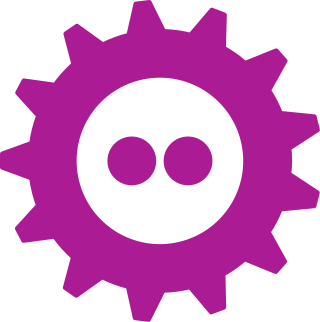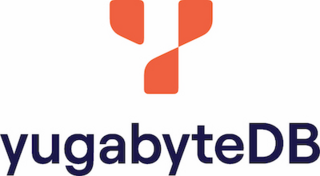
PostgreSQL also known as Postgres, is a free and open-source relational database management system (RDBMS) emphasizing extensibility and SQL compliance. PostgreSQL features transactions with atomicity, consistency, isolation, durability (ACID) properties, automatically updatable views, materialized views, triggers, foreign keys, and stored procedures. It is supported on all major operating systems, including Windows, Linux, macOS, FreeBSD, and OpenBSD, and handles a range of workloads from single machines to data warehouses, data lakes, or web services with many concurrent users.
Structured Query Language (SQL) is a domain-specific language used to manage data, especially in a relational database management system (RDBMS). It is particularly useful in handling structured data, i.e., data incorporating relations among entities and variables.

Free and Open source Software Developers' European Meeting (FOSDEM) is a non-commercial, volunteer-organized European event centered on free and open-source software development. It is aimed at developers and anyone interested in the free and open-source software movement. It aims to enable developers to meet and to promote the awareness and use of free and open-source software.
The following tables compare general and technical information for a number of relational database management systems. Please see the individual products' articles for further information. Unless otherwise specified in footnotes, comparisons are based on the stable versions without any add-ons, extensions or external programs.
In computing, a solution stack or software stack is a set of software subsystems or components needed to create a complete platform such that no additional software is needed to support applications. Applications are said to "run on" or "run on top of" the resulting platform.
Multi-master replication is a method of database replication which allows data to be stored by a group of computers, and updated by any member of the group. All members are responsive to client data queries. The multi-master replication system is responsible for propagating the data modifications made by each member to the rest of the group and resolving any conflicts that might arise between concurrent changes made by different members.

A LAMP is one of the most common software stacks for the web's most popular applications. Its generic software stack model has largely interchangeable components.

H2 is a relational database management system written in Java. It can be embedded in Java applications or run in client–server mode.
A spatial database is a general-purpose database that has been enhanced to include spatial data that represents objects defined in a geometric space, along with tools for querying and analyzing such data.
Point-in-time recovery (PITR) in the context of computers involves systems, often databases, whereby an administrator can restore or recover a set of data or a particular setting from a time in the past. Note for example Windows XP's capability to restore operating-system settings from a past date. Time Machine for Mac OS X provides another example of point-in-time recovery.
sync is a standard system call in the Unix operating system, which commits all data from the kernel filesystem buffers to non-volatile storage, i.e., data which has been scheduled for writing via low-level I/O system calls. Higher-level I/O layers such as stdio may maintain separate buffers of their own.
EnterpriseDB (EDB), a privately held company based in Massachusetts, provides software and services based on the open-source database PostgreSQL, and is one of the largest contributors to Postgres. EDB develops and integrates performance, security, and manageability enhancements into Postgres to support enterprise-class workloads. EDB has also developed database compatibility for Oracle to facilitate the migration of workloads from Oracle to EDB Postgres and to support the operation of many Oracle workloads on EDB Postgres.
Database administration is the function of managing and maintaining database management systems (DBMS) software. Mainstream DBMS software such as Oracle, IBM Db2 and Microsoft SQL Server need ongoing management. As such, corporations that use DBMS software often hire specialized information technology personnel called database administrators or DBAs.

Navicat is a series of graphical database management and development software produced by CyberTech Ltd. for MySQL, MariaDB, Redis, MongoDB, Oracle, SQLite, PostgreSQL and Microsoft SQL Server. It has an Explorer-like graphical user interface and supports multiple database connections for local and remote databases. Its design is made to meet the needs of a variety of audiences, from database administrators and programmers to various businesses/companies that serve clients and share information with partners.
Log shipping is the process of automating the backup of transaction log files on a primary (production) database server, and then restoring them onto a standby server. This technique is supported by Microsoft SQL Server, 4D Server, MySQL, and PostgreSQL. Similar to replication, the primary purpose of log shipping is to increase database availability by maintaining a backup server that can replace a production server quickly. Other databases such as Adaptive Server Enterprise and Oracle Database support the technique but require the Database Administrator to write code or scripts to perform the work.
Amazon Relational Database Service is a distributed relational database service by Amazon Web Services (AWS). It is a web service running "in the cloud" designed to simplify the setup, operation, and scaling of a relational database for use in applications. Administration processes like patching the database software, backing up databases and enabling point-in-time recovery are managed automatically. Scaling storage and compute resources can be performed by a single API call to the AWS control plane on-demand. AWS does not offer an SSH connection to the underlying virtual machine as part of the managed service.
Percona is an American company based in Durham, North Carolina and the developer of a number of open source software projects for MySQL, MariaDB, PostgreSQL, MongoDB and RocksDB users. The company’s revenue of around $25 million a year is derived from support, consultancy and managed services of database systems.

DBeaver is a SQL client software application and a database administration tool. For relational databases it uses the JDBC application programming interface (API) to interact with databases via a JDBC driver. For other databases (NoSQL) it uses proprietary database drivers. It provides an editor that supports code completion and syntax highlighting. It provides a plug-in architecture that allows users to modify much of the application's behavior to provide database-specific functionality or features that are database-independent. It is written in Java and based on the Eclipse platform.
TiDB is an open-source NewSQL database that supports Hybrid Transactional and Analytical Processing (HTAP) workloads. Designed to be MySQL compatible, it is developed and supported primarily by PingCAP and licensed under Apache 2.0. It is also available as a paid product. TiDB drew its initial design inspiration from Google's Spanner and F1 papers.

YugabyteDB is a high-performance transactional distributed SQL database for cloud-native applications, developed by Yugabyte.






